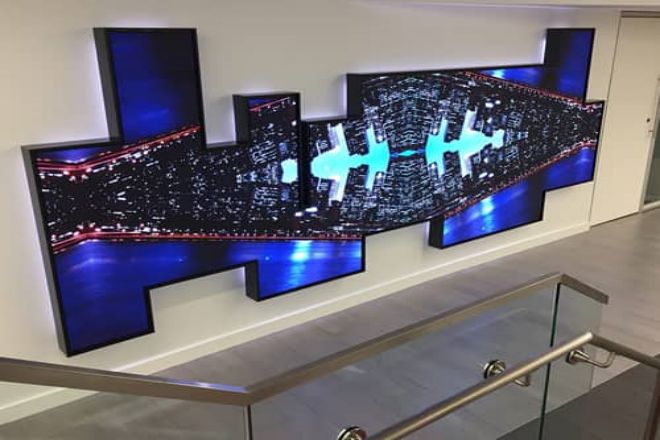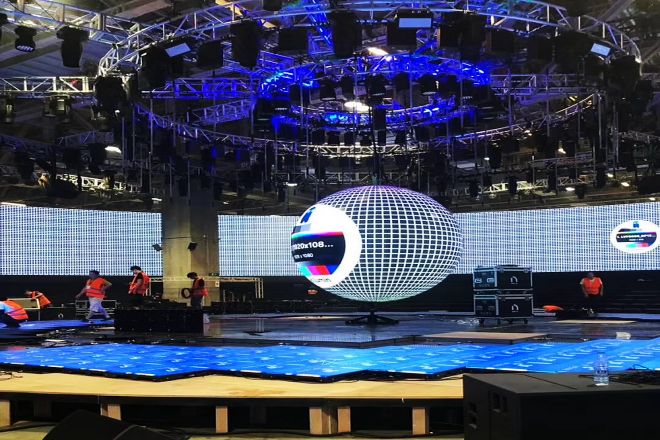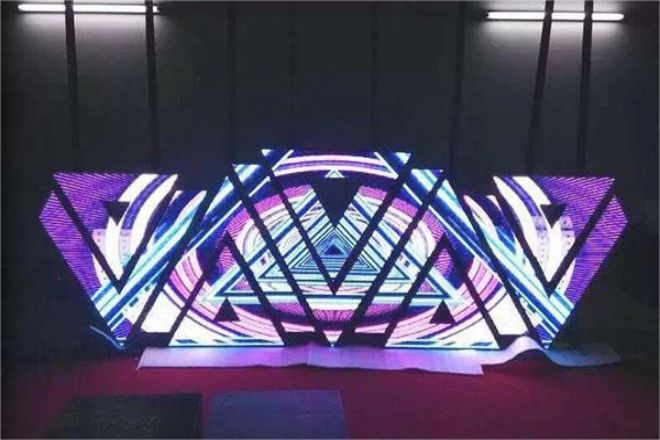مقدمة

في موجة العصر الرقمي، يعرض الصمام are no longer just a tool for information dissemination but also the crystallization of creativity and technology and a bridge connecting reality and dreams.
From traditional flat displays to today’s diversified and personalized displays, LED displays are evolving at an unprecedented speed. Among them, unconventional LED displays have become a bright new star in the field of visual arts with their unique form, excellent performance, and wide application scenarios.
These unconventional LED displays are either as smooth as silk and can be shaped or transparent as air, blending into the surrounding environment, or have different forms, challenging our traditional perception of “screens.” there are also masterpieces with ultra-high-definition micro-pitch, which show the beauty of details to the fullest.
They have not only brought revolutionary changes to advertising, entertainment, art, and other fields but also profoundly affected our lifestyle and aesthetic concepts.
1. What is an unconventional LED display?
Unconventional LED displays refer to display devices that exceed the scope of traditional standard LED displays in terms of design, form, application, or technical characteristics. Traditional LED display screens usually refer to screens composed of flat, rectangular LED display units arranged at a certain pixel pitch, which are mainly used in outdoor advertising, indoor information display, and other scenes.
Unconventional LED display screens break these conventional limitations and have one or more of the following characteristics:
- Diversified forms:
Unconventional LED display screens are no longer limited to flat and rectangular forms. They can be flexible, bendable, transparent, spherical, cylindrical, curved, wavy, and other special-shaped designs. This diversity enables LED display screens to better adapt to various complex or special installation environments and achieve more personalized and creative display effects.
- Technological advancement:
Unconventional LED display screens often use more advanced technologies and materials, such as micro-pitch technology, high-brightness LED chips, high refresh rate control systems, etc., to achieve higher resolution, wider viewing angles, smoother display effects, and lower power consumption. These technologies have significantly improved the picture quality, stability, and reliability of unconventional LED display screens.
- تطبيق واسع:
Due to the diversity of forms and technologies, unconventional LED display screens are also more widely used in the field of application. They are not only used for traditional advertising and information display but also gradually penetrate many fields such as stage performances, sports events, theme parks, art exhibitions, architectural decoration, etc., bringing unprecedented visual experience to these scenes.
- خدمة مخصصة:
Unconventional LED display screens usually need to be customized according to specific application scenarios and needs. This includes the adjustment of parameters such as screen size, shape, resolution, brightness, color, as well as supporting services in terms of installation structure, control system, content playback software, etc. Therefore, customized services have become a major feature of the unconventional LED display screen market.
2. The most used scenes of unconventional LED display screens

Unconventional LED display screens are increasingly used in various scenes due to their unique form, advanced technology, and wide range of applications. According to current information, the following are the most used scenes:
1). منصة performances and activities:
- Background walls and decorations:
LED display screens have become standard equipment for concerts, literary performances, exhibitions, and other occasions.
They can present exquisite background pictures, dynamic effects, and visual effects and enhance the atmosphere and viewing experience on the scene. High resolution, high color reproduction, and high visibility make LED display screens an important part of stage performances.
- Interactive devices:
In some creative exhibitions and art activities, unconventional LED screens are used as interactive devices to interact with the audience through touch, sensing, and other means, providing a unique sense of participation and experience.
2). Commercial centers and advertising displays:
- Special-shaped billboards:
In public places such as commercial centers and shopping centers, unconventional LED screens attract people’s attention with their unique shapes and creative designs. They can be spherical, cylindrical, or other special-shaped designs, bringing freshness to advertising.
- Transparent windows:
Transparent LED screens are widely used in store window displays. They can display in-store goods and background images at the same time, creating a visual effect of combining virtual and real, enhancing brand image and shopping experience.
3). Building curtain walls and decoration:
- LED screens + building curtain walls:
This combination has been popularized in many cities. LED screens not only have the function of energy-saving lighting but also can promote and convey information. They are used in urban landmark buildings, municipal buildings, commercial streets, and other places, becoming an important part of the city’s night view.
- Creative decoration:
Unconventional LED screens are also often used for exterior decoration or interior space decoration of buildings, creating a unique atmosphere and visual effects through dynamic images and color changes.
4). رياضات stadiums:
- Ring screens and central hanging screens:
In sports stadiums, unconventional LED displays are used as special forms such as ring screens or central hanging screens to display game information, live games, or advertising content. They can provide a full range of visual experiences to meet the viewing needs of the audience.
- Customized solutions:
Due to the special space and structure of sports stadiums, the customization requirements of unconventional LED displays are high. Manufacturers need to provide tailored solutions based on the actual conditions of the venues.
6) مجالات أخرى:
- Traffic induction:
In traffic hubs such as highways, bridges, and tunnels, unconventional LED displays can display road conditions, vehicle traffic instructions, etc., in real-time to improve traffic operation efficiency.
- بيان صحفي:
In public places such as schools, hospitals, banks, and hotels, unconventional LED displays can release various information, such as notices, announcements, news, etc., to provide timely and accurate information services.
It should be noted that the above scenarios are only part of the application of unconventional LED displays. With the continuous advancement of technology and the continuous expansion of the market, the application areas of unconventional LED displays will continue to expand.
At the same time, due to the different needs and conditions of different scenarios, the customized services of unconventional LED displays will become more and more important.
3. The difference between unconventional LED display and traditional LED display
There are significant differences between unconventional LED displays and traditional LED displays, which are mainly reflected in the form design, technical characteristics, application scenarios, and user experience. The following is a detailed analysis of these differences:
1). Form design
1.1). Traditional LED display:
Standard form: usually a flat, rectangular structure with pixels arranged at a fixed pitch.
Fixed installation: The installation position is relatively fixed, and it is not easy to change the shape or size.
1.2). Unconventional LED display:
Diversified form: can be flexible, transparent, spherical, cylindrical, curved, wavy, and other special-shaped designs.
Customization: Customized design according to specific application scenarios and needs, such as adjustment of screen size, shape, resolution, brightness, and other parameters.
2). Technical characteristics
2.1). Traditional LED display:
Standard technology: using mature LED display technology with a stable display effect and long service life.
Limited flexibility: There are certain limitations in pixel pitch, brightness, color, and other aspects, and it is difficult to meet all special needs.
2.2). Unconventional LED display:
Advanced technology: often using more advanced technology and materials, such as micro-pitch technology, high-brightness LED chips, high refresh rate control systems, etc.
High flexibility: It has higher flexibility and adjustability in terms of resolution, brightness, color, viewing angle, etc., and can meet more special needs.
3) سيناريوهات التطبيق
3.1). Traditional LED display screen:
Wide application: Suitable for outdoor advertising, indoor information displays, stadiums, and other scenarios.
Standardized application: More used in occasions that require standard size and display effect.
3.2). Unconventional LED display screen:
Diversified application: Not only suitable for traditional scenes but also widely used in stage performances, commercial exhibitions, architectural decoration, traffic induction, and other occasions that require special forms and creative designs.
Creative display: Through unique forms and creative designs, it brings a new visual experience to the audience.
4). User experience
4.1). Traditional LED display screen:
Stable and reliable: Provide stable and reliable display effects to meet basic viewing needs.
Limited interaction: Relatively limited in interactivity and user experience.
4.2). Unconventional LED display screen:
Enhance immersion: Enhance the audience’s immersion and participation through special-shaped design and dynamic pictures.
Enhance attractiveness: Unique visual effects and high flexibility can attract more audience attention and interest.
4. How do we use them to achieve the best effect?

In order to achieve the best effect with unconventional LED display screens, you can follow the following suggestions:
1) التحضير الأولي
1.1). Clear application scenarios and requirements:
Choose the appropriate type of unconventional LED display screen according to the specific application scenarios (such as stage performances, commercial exhibitions, architectural decoration, etc.) and requirements (such as size, shape, resolution, brightness, etc.).
1.2). Professional design and customization:
Cooperate with professional LED display screen manufacturers or design companies for customized design. Ensure that the design plan meets the characteristics and requirements of the application scenario, while taking into account the convenience of installation, debugging, and maintenance.
1.3). Ensure voltage and current stability:
Electronic products are afraid of unstable voltage and current, which will have a great impact on LED display screens. Therefore, before use, ensure the stability of the power supply voltage and current to avoid instantaneous peaks from damaging the display screen.
2). Installation and debugging
2.1). Correct installation:
Install according to the design plan and the installation guide provided by the manufacturer. Ensure that the display screen is installed firmly and flatly and that the connection lines are correct.
2.1). Debugging and testing:
After the installation is completed, debug and test. Check whether the display effect, brightness, color, contrast, and other parameters of the display screen meet the requirements. At the same time, ensure that the control software and playback equipment can work normally and achieve seamless docking with the display screen.
2.3). Avoid dust and moisture:
During the installation and debugging process, pay attention to avoid the impact of dust and moisture on the display. If there is a lot of dust or high humidity in the environment, appropriate dust and moisture-proof measures should be taken.
3). Use and maintenance
3.1). Standard operation:
During use, follow the correct operating procedures and safety regulations.
For example, when turning on and off the machine, follow the order of turning on the screen first and then turning on the machine, and turning off the machine first and then turning off the screen; avoid turning on the screen in a full white screen state or in an out-of-control state.
3.2). Regular maintenance:
Regularly maintain and service the display, including cleaning the screen, checking the connection lines, adjusting parameters, etc. This helps to extend the service life of the display and improve the display effect.
3.3.). Reserve rest time:
Although the LED display can be used for a long time, it also needs proper rest. Especially after continuous use for a long time, the display should be turned off and let rest for a while to avoid overheating and damage.
3.5). Pay attention to environmental factors:
During use, pay attention to the impact of environmental factors on the display. For example, avoid using the display on thunderstorm days; pay attention to heat dissipation or heat preservation when using it in high or low-temperature environments; pay attention to adjusting brightness and contrast under strong light, etc.
- الصيانة المهنية:
If the display fails or is damaged, you should contact professional maintenance personnel as soon as possible for repair or replacement. Avoid disassembly or repair by yourself, which may cause greater damage or safety hazards.
- Creativity and content Creative design:
Use the unique form and characteristics of unconventional LED displays for creative design. Enhance the audience’s visual experience and sense of participation through dynamic images, color changes, interactive effects, etc.
High-quality content: Prepare high-quality content for playback. The content should be consistent with the application scenario and attractive and appealing. At the same time, pay attention to the update and replacement of content to keep the audience fresh and interested.
خاتمة
With the continuous advancement of technology and the infinite surge of creativity, unconventional LED displays are changing our visual experience at an unprecedented speed. They are not only a display of technology but also a perfect fusion of art and technology and a manifestation of the spirit of the times.
أخيرًا، إذا كنت تريد معرفة المزيد عن شاشات LED، يرجى الحصول على اتصال معنا.
